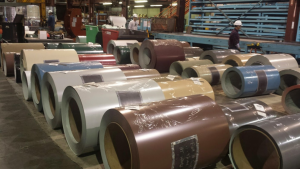Welcome to Ask the Pole Barn Guru – where you can ask questions about building topics, with answers posted on Mondays. With many questions to answer, please be patient to watch for yours to come up on a future Monday segment. If you want a quick answer, please be sure to answer with a “reply-able” email address.
Email all questions to: PoleBarnGuru@HansenPoleBuildings.com
 DEAR POLE BARN GURU: I live in a wooded area and want to erect a pole barn to survive moisture and critters. how about a design with cement floor and cement walls going up 4 feet tall, before the regular walls start, and go two stories tall. Do you have a design or insights. RICHARD IN CERESCO
DEAR POLE BARN GURU: I live in a wooded area and want to erect a pole barn to survive moisture and critters. how about a design with cement floor and cement walls going up 4 feet tall, before the regular walls start, and go two stories tall. Do you have a design or insights. RICHARD IN CERESCO
DEAR RICHARD: Pole barns work well on both full and partial concrete walled foundations.
I happen to live on a lake, which is nestled into a mountain valley. For the most part, the parcels of land around the lake tend to be very narrow and very steep (only so much lake frontage exists, therefore the narrow lots). In my case, the lot gains well over 100 feet of elevation from lake to back, over the 250 feet of depth.
With the lake as my “front” yard, on the back of my lot is a pole building upon which the site had 12 feet of grade change in 40 feet. The solution was to excavate to the lowest point, then construct a foundation on the “high” sides. In my case, we used eight inch insulated Styrofoam blocks, poured with concrete – one wall being 12 feet tall, and the other sides appropriately steeped to match the land contours.
Steel brackets engineered to withstand moment (bending) forces were poured into the top of the walls to attach the pole building columns.
The direct answer to your question is – yes. Whether a full basement, partial basement, or daylight basement (the last being closest to my particular case), pole buildings can be attached to any adequately designed foundation wall. We prefer to use wet set brackets (those embedded in the concrete wall at time of pour) as opposed to dry set brackets (those attached to the concrete wall with bolts) for a sturdier connection, but either one can be used.
Oh, by the way, my own building happens to have two full stories above the foundation walls, the tall wall being the height of the ‘basement’ ceiling!
DEAR POLE BARN GURU: Have my pole building up and my heated shop and storage area framed and ready to insulate, let me list the approach I have taken mostly from your blog, steel roof panels with drip stop lining on purlins, soffit and ridge venting. All side walls have typed house wrap under the steel on top of purlins, with book shelf the side walls and use 6in watts, then install vapor barrier over watts and under sob finish, my question is I am gong to use steel liner panel for my ceiling with blown in insulation or unfaced attic blanket above it, should I use a 6mil vapor barrier above my liner panel like the walls or something else, any help would be appreciated greatly, thanks again great blog you have here. GARY IN AMERICA
DEAR GARY: Thank you for all of your kind words, I am humbled. Most of all, I am glad to have assisted you.
While you know I am not a fan of steel liner panels for ceilings to begin with – if you are going to do so, then there should not be vapor barrier above the steel. Ideally, you would source perforated steel panels, so warm moist air from inside the building has a place to escape. With solid steel ceiling liner panels, there is a distinct possibility you will need to add exhausts of some sort, in order to reduce the humidity in your building.
DEAR POLE BARN GURU: My pole building has frost heave problems. Some poles are up as much as a foot and some are still at original grade. The front left corner is up and the right rear corner is up. The other two corners are close to original grade. I don’t know how deep the poles go into the ground, but I suspect that they don’t go below frost and don’t have concrete under them. I have only owned the building for less than a year and the original owner hasn’t been able to give me much information about the original construction. About 10 years ago, the poles were undermined and the building was put back to it’s original grade. At that time, they wrapped the posts in styrofoam before backfilling. Apparently this helped slow down the frost heave situation, but the building is still moving. The ground is pretty wet behind the building. There is a small hill behind the building. I plan to put a tile in around the building before I do anything else so I can dry out the foundation. My question is, is there any frost protected shallow foundation design concept that could be used in this case if the existing posts don’t extend below the frost line? I was thinking that once I tile around the building to remove water and undermine the posts to get it back to grade, I could excavate down to a depth as stipulated by the “Revised Builders Guide to Frost Protected Shallow Foundations” https://www.albertasoils.com/docs/revisedfpsfguide_sept2004.pdf,
Both inside the building and around the perimeter of the building; place a horizontal insulation layer under the building and around the perimeter to a horizontal distance specified in the guide and then backfill with a clean crushed stone (non-frost susceptible material) on top of the insulation to the original floor grade without having to replace the posts with longer posts to get them below frost. Is this a bad idea? I haven’t gone through the design steps yet, but I’m thinking that I may not need to excavate and replace more than two feet of material plus add an insulating layer to accomplish this. Thanks for your response! DAN IN WINTER
DAN: The least expensive and most likely to get you the results you are looking for will be to get rid of the water. Beyond this – it is possible any remediation will cost more than your building is worth. It would possibly behoove you to hire a registered professional engineer to examine your challenges and give you a solution (or solutions) which will provide for you a satisfactory resultant.









Helpful post
I’m in something of a similar position as Richard, and it’s great to know that moisture won’t be too much of a problem for a pole barn. Getting cement in the walls and ceiling was something I was somewhat worried about, but it’s great to know that they can be attached to a foundation wall without a problem. I like the idea of getting steel brackets for the project, and it’s great that they work as wet-set brackets.
Always great to know other providers of post frame building kit packages are reading these articles!
In a similar situation. Realizing that codes and specs will vary from place-to-place (we are building in TN), in your experience as a pole barn contractor and guru, what is the minimum thickness you feel the concrete walls should be for post-frame construction using 6×6 or 8×8 posts?
At a minimum walls should be as thick as the dimension of the columns above.